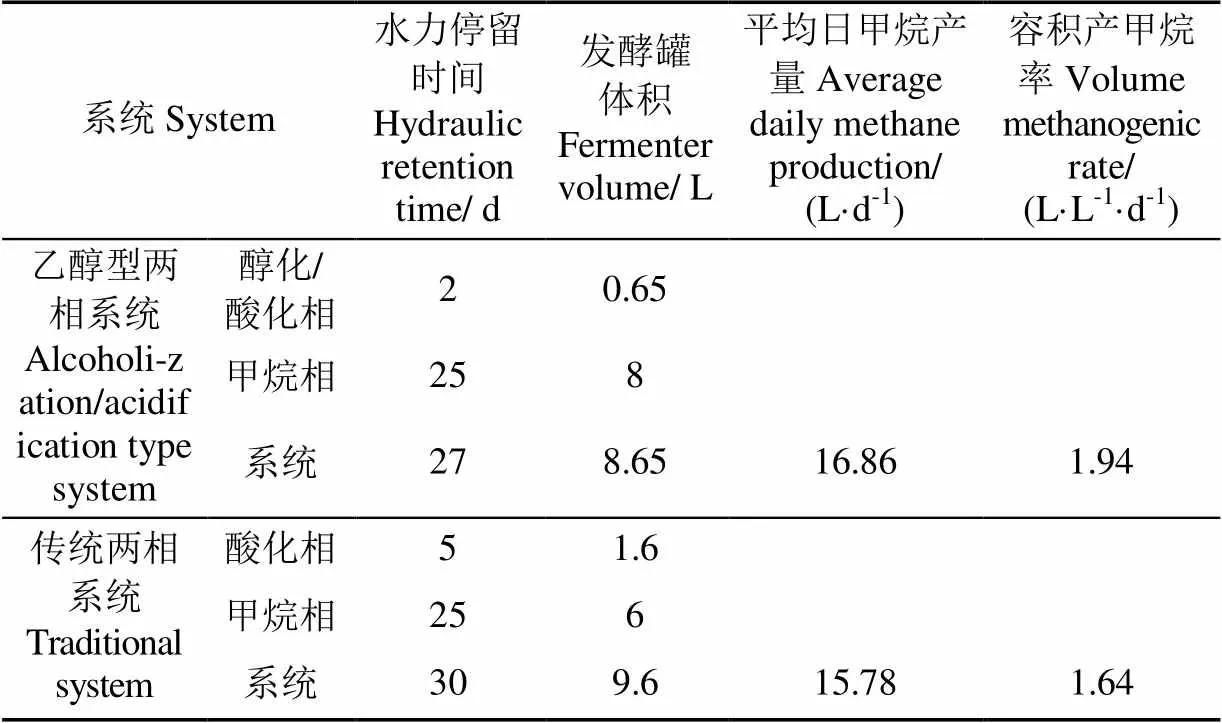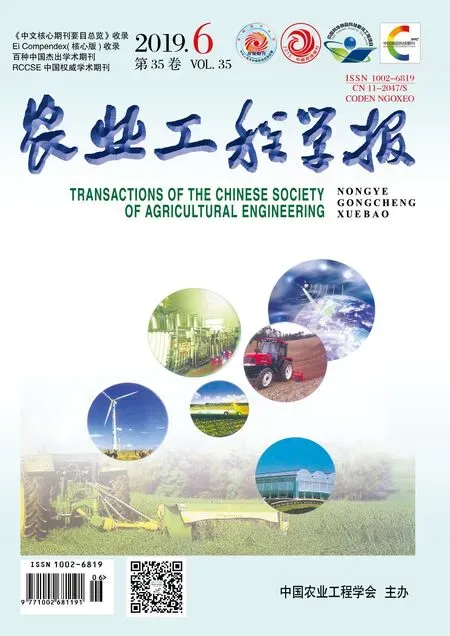餐厨垃圾半连续乙醇型酸化两相厌氧消化产甲烷性能研究
于 淼,高 明,2,吴川福,2,任媛媛,马欣欣,汪群慧,2
餐厨垃圾半连续乙醇型酸化两相厌氧消化产甲烷性能研究
于 淼1,高 明1,2,吴川福1,2※,任媛媛1,马欣欣1,汪群慧1,2
(1. 北京科技大学能源与环境工程学院环境工程系,北京 100083; 2. 工业典型污染物资源化处理北京市重点试验室,北京 100083)
为了解乙醇型两相厌氧消化系统性能,该研究构建了以接种酵母菌产乙醇同时产酸为特征的餐厨垃圾两相厌氧消化系统(乙醇型两相),并开展系统的进料有机负荷率由2.0 g/(L·d)逐渐提高至6.0 g/(L·d) 的半连续厌氧发酵产甲烷试验。结果表明:乙醇型两相在5.0 g/(L·d)时甲烷产率为421.52 mL/g,比传统两相厌氧消化系统的394.48 mL/g,提高了6.8%。乙醇型的醇化/酸化相的水解产物中乙醇占33.4%,这有利于水解物料进入甲烷相后保持该相pH值及厌氧消化的稳定运行。与传统两相相比,乙醇型两相系统的醇化/酸化相水力停留时间减少了60%,系统的有效容积减少了10.6%,容积产甲烷率提高了18.3%。说明乙醇型两相比传统型两相系统在产甲烷性能方面具有明显的优势,且有提高系统稳定性的潜力。
垃圾;发酵;甲烷;两相厌氧消化;醇化/酸化相;有机负荷
0 引 言
中国由餐厨垃圾所引发的社会问题如“地沟油”等逐渐被社会所关注。餐厨垃圾具有高油脂(5%~20%)、高盐分(湿基0.8%~1.5%)、高水分(70%~90%)、高有机含量(干基90%以上)以及易腐发臭、易酸化等特点[1],它们也是填埋场气体和渗滤液产生的主要来源[2],造成填埋场二次污染防治费用大量增加。餐厨垃圾的热值低,不仅不能自燃,而且会妨碍焚烧炉内温度的上升,并可能引起二恶英的合成[3]。但餐厨垃圾具有营养丰富,生物降解性好,产甲烷潜能高等特点,是良好的甲烷发酵底物。餐厨垃圾厌氧消化可降解复杂的底物成分,沼气易分离、易于工程应用,是目前最具潜力的餐厨垃圾资源化方式[4-5]。
复杂有机物的厌氧消化过程可以分为3个阶段,水解阶段、产酸阶段和产甲烷阶段,整个过程主要由水解细菌、酸化细菌、产氢产乙酸细菌和产甲烷菌4类微生物完成[6-7]。故通过人为的构建水解酸化相包括水解细菌和酸化细菌和产甲烷菌包括产氢产乙酸细菌和产甲烷菌,使得各相中的微生物处于各自适宜的环境下以提高系统的处理效率和稳定性。同时也存在着系统投资较大,运行控制复杂等问题。
本课题组的研究发现通过在餐厨垃圾底物中接种酵母菌进行开放式乙醇发酵,可以降低底物酸化对系统的影响并提高其厌氧消化稳定性[8-10]。底物乙醇预发酵可以视为一种底物的预处理手段,但该方法以往的研究都用于批式厌氧消化中,尚未开展餐厨垃圾连续厌氧消化的相关研究。故本试验目的在于通过接种酵母菌构建以第一相为开放式产乙醇发酵为主同时又有底物自身的产酸细菌发酵为特征的醇化/酸化相,并与后续的产甲烷相串联组成乙醇型两相厌氧消化系统(简称乙醇型两相)。与传统的两相厌氧消化系统(简称传统两相)在相同的进料负荷下进行对比。为了分析2个系统的稳定性的差异,进料有机负荷由2 g/(L·d)逐步提高至6 g/(L·d),分析在高进料有机负荷率下系统稳定性及挥发性脂肪酸(volatile fatty acids,VFAs)、碱度、pH值的变化,以期为构建新型乙醇型两相厌氧消化系统提供科学依据。
1 材料与方法
1.1 试验材料
餐厨垃圾取自北京科技大学学生食堂,经简单分拣、绞碎后放入冰箱(-20 ℃)冷藏备用,接种污泥取自肖家河污水处理厂二沉池出泥并在实验室驯化1个月时间,其中厌氧消化污泥的驯化方法为35 ℃下在5 L发酵罐中每3 d添加30 g餐厨垃圾。餐厨垃圾和接种污泥原料的主要成分指标见表1。
1.2 试验装置和试验方法
两相厌氧消化方法:根据以往张笑等[1]对餐厨垃圾批式厌氧消化的研究结果,选取2 d作为乙醇型两相厌氧消化系统中第一相醇化/酸化相的水力停留时间(hydraulic retention time,HRT)。其中乙醇型水解醇化/酸化相不接种污泥,除每日进料外,按照底物质量的0.5%接种活化后的酿酒酵母菌粉(安琪酵母有限公司)进行开放式发酵。开放式发酵是指本试验中底物不灭菌直接接种酵母菌进行厌氧发酵。乙醇型两相系统的第一相体积为0.65 L。

表1 餐厨垃圾和接种污泥的化学特征
注:* 以干基计。
Note:: * refers to a dry basis.
根据本课题组以往对餐厨垃圾两相厌氧消化系统第一相水解酸化相在不同HRT(2、5、8 d)下的对比研究发现,HRT为5和8 d时,第一相的水解酸化效果稳定,考虑到提高系统处理效率和节省反应器体积的目的,在本试验中选择了5 d作为传统两相系统第一相(酸化相)的HRT。传统两相系统的第一相体积为1.60 L。两系统的产甲烷相均为全混式厌氧消化罐(continuous stirred-tank reactor,CSTR),体积为10 L,有效容积为8 L,HRT为25 d,两系统初始进料有机负荷率(organic loading rate,OLR)均为2 g/(L·d),且每10~15 d提高1 g/(L·d)有机负荷,每日固定时间进料1次(也称为半连续厌氧发酵),第一相的出料进入产甲烷相。将 2个系统的发酵罐放置于THZ-82数显恒温气浴振荡器内,保持温度(35±1)℃,转速60 r/min,每日取样分析甲烷产量及出料发酵液中pH值、总挥发性有机酸(TVFA)浓度、乙醇浓度、碱度等。所有组别设置3组平行试验组。
1.3 分析方法
本研究利用减质量法[11]分析总固体(total solid,TS)、挥发性固体(volatile solid,VS)及灰分含量,样品中的pH值采用PHS-3C型pH计测定。挥发性脂肪酸组成含量采用气相色谱仪(GC)测定[12-13]。乳酸含量采用液相色谱仪(LC)测定[14]。产生的气体由气袋收集后用排水法测定沼气体积,利用气相色谱仪测定甲烷组分[15]。厌氧消化系统中的碱度利用溴甲酚绿-甲基红指示剂滴定法测定。
2 结果与分析
2.1 乙醇型与传统两相厌氧消化系统的产气性能对比分析
将餐厨垃圾按1.2节所述的试验方法进行了乙醇型和传统型2个厌氧消化试验,两系统产甲烷量及底物降解率如图1所示。
由图1a中可以看出,在OLR为2 g/(L·d)至5 g/(L·d)的范围内,两系统的日产甲烷量均随OLR的增加而升高,在5 g/(L·d)达到产气峰值,其中,乙醇型两相系统水解醇化/酸化相pH值较高且稳定。而当OLR提高至6 g/(L·d)后2个系统均失稳、产气量下降,维持OLR为6 g/(L·d) 10 d后,2个产甲烷相的pH值均降至6.5以下,系统完全酸化崩溃。由此可知5 g/(L·d)为本研究2个系统能稳定运行的最大进料有机负荷率,这与目前研究报道的餐厨垃圾进料负荷范围接近[16-17]。从图1b中可以看到2个厌氧消化系统平均甲烷产率随OLR的变化。由表1餐厨垃圾的组成可算出本研究所用底物的理论化学分子式为C27.5H48.7O12.7N,根据Nielfa报道的计算公式[18],理论最大甲烷产率为612.3 mL/g。2个系统中,乙醇型、传统型两相厌氧系统在3 g/(L·d)时的达到最高甲烷产率,分别为486.3 mL/g、438.0 mL/g,是各系统理论产甲烷量的79.4%和71.5%。表2比较了有机负荷率5 g/(L·d)时,两系统容积产甲烷率等产气性能。

图1 乙醇型与传统型厌氧消化系统的产甲烷效果、pH值及底物降解率
由表2可知,在最大进料有机负荷(5 g/(L·d))条件下,乙醇型两相系统的平均日甲烷产量和平均容积产甲烷率分别为16.86和1.94 L/(L·d),比传统型两相系统分别提高了6.8%和18.3%;乙醇型两相的产甲烷率为421.52 mL/g,传统两相的为394.48 mL/g。这是由于乙醇型两相系统的水解醇化/酸化相水力停留时间比传统两相减少60%,含两相系统的有效容积比传统两相减少了10.6%,故整个系统的容积产气率显著提高,说明乙醇型两相系统在工业应用中可减少装置的占地面积,并节约维持系统发酵温度的能耗。下面将从2个系统中水解酸化相的碳源流向、及甲烷发酵过程VFAs、碱度、pH值等重要指标来分析乙醇型两相优于传统型两相的原因。

表2 厌氧消化系统在5 g·L-1·d-1负荷时的产气性能
2.2 水解酸化相中水解产物流向趋势
厌氧消化过程中,底物中的大分子有机物由产酸产醇细菌转化为小分子脂肪酸(VFA)、乳酸、乙醇等水解产物,随后在产甲烷古细菌的作用下,转化为CH4和CO2[6-7]。水解酸化是厌氧消化的限速步骤[7,19-20],故提高其效率将有利于厌氧消化的进行。2个系统在初始负荷2 g/(L·d)时的VFAs浓度较低,碱度、pH值等指标区别也不明显,故从3 g/(L·d)有机负荷率提高至6 g/(L·d) 期间(厌氧化第15 天至第65 天),水解酸化相中VFAs(含乙酸、丙酸、丁酸)、以及乳酸、乙醇等浓度的变化进行取样分析,其结果如图2所示。
在乙醇型两相厌氧消化系统中,接种酵母菌后,系统中的乙醇质量浓度维持在5.5~6.0 g/L,且水解产物浓度由高到低的顺序为:乳酸>乙醇>乙酸>丙酸≈丁酸(图 2a);这是由于该乙醇型两相系统中,餐厨底物未经过灭菌直接进入水解醇化/酸化相,存在着大量天然产酸细菌,故该系统水解醇化/酸化相中既有乙醇又有酸产生。而传统型两相厌氧消化系统中水解产物浓度由高到低的顺序为:乳酸>乙酸>丁酸>丙酸>乙醇(见图2b),系统中丁酸大量产生的原因可能与系统中的产酸细菌群落相关,在该负荷下发生了丁酸型发酵。在本研究的整个厌氧消化过程中,2个厌氧消化系统中都观察到了乳酸质量浓度稳定在6.0~9.0 g/L,这也是餐厨垃圾底物的特点所致,由于中国的饮食习惯,餐厨垃圾中乳酸菌是优势菌种[9,12,21],土著乳酸菌浓度在105~106CFU/mL[9]。
将本研究水解酸化相中VFAs(含乙酸、丙酸、丁酸)、以及乳酸、乙醇等浓度的总和定义为水解产物总量,为了直观的分析2个系统中底物在水解酸化相中的中碳源流向,将2个系统各进料有机负荷阶段(3.0~6.0 g/(L·d))水解产物浓度的平均值列于表3中。

图2 乙醇型与传统型厌氧消化系统水解酸化相中主要水解产物的浓度变化
由表3可以看出,乙醇型两相和传统两相系统的水解产物总量进料有机负荷3、4、5 g/(L·d)的发酵中,乙醇型系统醇化/酸化相中乙醇占水解产物总量的比例分别为41.47%、36.98%、33.41%,是传统两相系统的几十倍,且乙醇与乙酸之和占水解产物总量的比例也维持在48%~54%范围内,也高于传统两相;而传统两相的水解产物以其他有机酸(丁酸、乳酸、丙酸)为主(61%以上),它们占水解产物总量的比例比乙醇型系统高15~23个百分点。这表明乙醇型的醇化/酸化相中,更多的碳源被转化为乙醇和乙酸,而传统的酸化相中更多的碳源转化为丁酸、乳酸和丙酸。
根据厌氧消化过程中乙醇、丙酸、乳酸、丁酸等都需转化为乙酸后再降解为甲烷(化学式(1)~(4))。由反应过程的吉布斯自由能可知,相对于丙酸和丁酸,乙醇反应为乙酸所需自由能较低容易转为乙酸,从而促进了产甲烷阶段中乙酸产甲烷途径的进行[12],即乙醇相当于缓释的乙酸[22]。因此,乙醇型的醇化/酸化相中高比例的乙醇+乙酸为后续产甲烷相提供了易于产甲烷菌降解的消化底物,并使其在高进料有机负荷率条件下缓解VFAs累积,维持系统稳定。

表3 乙醇型和传统两相厌氧消化系统水解酸化相中碳源流向比较
注:*本研究定义的水解产物总量=总挥发性脂肪酸(乙酸+丙酸+丁酸+异丁酸+戊酸+异戊酸)+乙醇+乳酸。
Note:: In this study, hydrolysate was defined that hydrolysate=TVFA (acetic acid+propionic acid+butyric acid+isobutyric acid+valerate+isovalerate)+ethanol+lactic acid.




2.3 乙醇型和传统两相厌氧消化系统的甲烷相中挥发性脂肪酸等指标的对比分析
图3显示2个系统在OLR为3至6 g/(L·d)的范围内,甲烷相中的VFAs浓度均随OLR的升高而升高。在3和4 g/(L·d)时,2个甲烷相中的TVFA浓度均小于4 g/L,pH值在7.5左右(图1a)。这表明了厌氧系统的运行状态稳定,酸化相所产生的水解产物能够有效的降解转化为CH4,从而甲烷相中没有VFAs过多的累积。这与运行良好的厌氧消化系统性能吻合[23-24]。当OLR提高至5 g/(L·d)后,系统中的VFAs开始明显累积,其中传统两相系统的TVFA最高质量浓度为8.28 g/L大于乙醇型的7.01 g/L,且pH值下降,系统有酸化失稳趋势。
有研究表明,TVFA/碱度比值可以作为餐厨垃圾厌氧消化系统的抗酸化性能的判别指标。当TVFA/碱度<0.4时,认为厌氧消化系统具有足够的缓冲能力;当TVFA/碱度=0.4~0.8时,认为厌氧消化系统具备一定的缓冲能力,但缓冲能力有限;当TVFA/碱度>0.8时,认为系统缓冲能力极小,挥发酸有出现累积的可能性,应密切关注系统的变化并及时采取相应的控制措施避免系统性能进一步恶化。在本研究中,2组厌氧消化系统在负荷<3.0 g /(L·d)时,TVFA/碱度值较为稳定,之后随着负荷的增加,TVFA/碱度值迅速增加。其中当负荷达到5.0 g/(L·d)时,乙醇型两相系统的TVFA/碱度值缓慢增加在该负荷下的最后一天接近0.4。而传统两相系统在该负荷下TVFA/碱度平均值为0.7,最大TVFA/碱度值为0.9,其系统变得不稳定,对酸的缓冲能力急剧下降,其碱度已不足以中和所产生的VFA,VFA浓度过高,将会抑制产甲烷菌的活性,这也解释了在该负荷下,传统两相系统的甲烷产率明显下降。此时,两系统的pH值仍然大于7.2,仍处于甲烷菌的适宜pH值范围。但此时从TVFA/碱度来看,系统已经有失稳趋势,可见TVFA/碱度是一个比pH值更加敏感的指标,这与其他研究结果一致[25-26]。综上,TVFA/碱度,可作为监测厌氧消化系统稳定运行的指标之一。

图3 乙醇型和传统两相厌氧消化系统甲烷相出料的VFA组成及VFA/碱度比值对比
进一步分析高OLR下的VFAs各组分的变化,2组系统中丙酸质量分数均较高(>25%)。从厌氧消化过程中VFAs转化为甲烷的吉布斯化学自由能分析(化学式2)[8],丙酸是所有挥发性脂肪酸中较难被产甲烷菌降解的物质,其在产甲烷相中的累积,会对产甲烷菌的活性产生抑制。目前丙酸抑制浓度尚无统一报道,但有丙酸浓度升高导致系统失稳的报道,如Wang等[27]报道了当丙酸质量浓度超过0.9 g/L后,系统中的产甲烷菌数量下降一个数量级。本研究在3、4、5、6 g/(L·d)时,乙醇型系统的平均丙酸浓度分别为0.32、0.67、1.11和1.82 g/L,传统型系统丙酸浓度增加更为显著,在5 g/(L·d)时是乙醇型两相系统的1.23倍,此时应停止增加有机负荷,以维持系统稳定。
综上所述,由5 g/(L·d)有机负荷条件下的丙酸浓度、VFA/碱度比值等指标可以推测,在该有机负荷条件下乙醇型系统的稳定性高于传统型系统。
3 结 论
1)以餐厨垃圾为底物,产乙醇同时产酸为特征的乙醇型两相系统与传统产酸产甲烷两相系统在不同有机负荷下的厌氧消化试验结果表明:5.0 g/(L·d)为乙醇型和传统两相厌氧消化2个系统稳定运行的最大负荷,此时乙醇型两相系统甲烷产率为421.52 mL/g,比传统两相的394.48 mL/g提高了6.8%。
2)乙醇型两相系统的醇化/酸化相水力停留时间比传统两相减少60%,就整个系统而言,乙醇型两相系统的有效容积比传统两相减少了10.6%,从而导致容积产气率的提高。如在5.0 g/(L·d)负荷时,乙醇型两相厌氧消化系统容积产气率比传统系统提高了18.3%,有利于在工业应用中减小装置占地面积及节约水解酸化所需能耗。
3)对乙醇型两相和传统两相系统的水解醇化/酸化相水解产物分析发现,在3.0和4.0 g/(L·d)负荷时,2组的水解产物总量接近,当5.0 g/(L·d)负荷时乙醇型两相水解醇化/酸化相水解产物中乙醇占33.4%,高于传统两相系统,而丙酸浓度低于传统两相系统,这有利于水解物料进入产甲烷相后保持产甲烷相pH值和碱度,具有提高厌氧系统稳定性的潜力。
[1] 张笑,宋娜,汪群慧,等. 乙醇预发酵对餐厨垃圾与酒糟混合甲烷发酵的影响[J]. 农业工程学报,2014,30(19):257-264. Zhang Xiao, Song Na, Wang Qunhui, et al. Effect of ethanol pre-fermentation on methane fermentation during anaerobic co-digestion of kitchen waste and vinasse[J]. Transactions of the Chinese Society of Agricultural Engineering (Transactions of the CSAE), 2014, 30(19): 257-264. (in Chinese with English abstract)
[2] Ma Hongzhi, Xing Yi, Yu Miao, et al. Feasibility of converting lactic acid to ethanol in food waste fermentation by immobilized lactate oxidase[J]. Applied Energy, 2014, 129: 89-93.
[3] Ren Yuanyuan, Yu Miao, Wu Chuanfu, et al. A comprehensive review on food waste anaerobic digestion: Research updates and tendencies[J]. Bioresource Technology, 2018, 247: 1069-1076.
[4] 许勇. 餐厨垃圾两相厌氧发酵性能的研究[D]. 哈尔滨:东北林业大学,2014.Xu Yong. Performance of Two-Phase Anaerobic Fermentation of Food Waste[D]. Harbin: Northeast Forestry University, 2014. (in Chinese with English abstract)
[5] Kawai Minako, Nagao Norio, Tajima Nobuaki, et al. The effect of the labile organic fraction in food waste and the substrate/inoculum ratio on anaerobic digestion for a reliable methane yield[J]. Bioresource Technology, 2014, 157: 174-180.
[6] Zhang Cunsheng, Su Haijia, Baeyens Jan, et al. Reviewing the anaerobic digestion of food waste for biogas production[J]. Renewable and Sustainable Energy Reviews, 2014, 38: 383-392.
[7] Lee Eunyoung, Cumberbatch Jewel, Wang Meng, et al. Kinetic parameter estimation model for anaerobic co-digestion of waste activated sludge and microalgae[J]. Bioresource Technology, 2017, 228: 9-17.
[8] Wu Chuanfu, Wang Qunhui, Yu Miao, et al. Effect of ethanol prefermentation and inoculum-to-substrate ratio on methane yield from food waste and distillers’ grains[J]. Applied Energy, 2015, 155: 846-853.
[9] Zhao Nana, Yu Miao, Wang Qunhui, et al. Effect of ethanol and lactic acid pre-fermentation on putrefactive bacteria suppression, hydrolysis, and methanogenesis of food waste[J]. Energy & Fuels, 2016, 30(4): 2982-2989.
[10] Yu Miao, Wu Chuanfu, Wang Qunhui, et al. Ethanol prefermentation of food waste in sequencing batch methane fermentation for improved buffering capacity and microbial community analysis[J]. Bioresource Technology, 2018, 248(Part A): 187-193.
[11] American Public Health Association, American Water Works Association, Farber Lawrence. Standard Methods for the Examination of Water and Wastewater[M]. 18th edition. Washington: American Public Health Association, 1992.
[12] Wu Chuanfu, Huang Qiqi, Yu Miao, et al. Effects of digestate recirculation on a two-stage anaerobic digestion system, particularly focusing on metabolite correlation analysis[J]. Bioresource Technology, 2018, 251: 40-48.
[13] Wu Chuanfu, Wang Qunhui, Xiang Juan, et al. Enhanced productions and recoveries of ethanol and methane from food waste by a three-Stage process[J]. Energy & Fuels, 2015, 29(10): 6494-6500.
[14] 孙绪顺,褚春凤,李春杰. 反相高效液相色谱测定厌氧反应上清液中挥发性脂肪酸[J]. 净水技术,2009,28(5):64-66. Sun Xushun, Chu Chunfeng, Li Chunjie. Determination of volatile fatty acids in anaerobic reaction by high performance liquid chromatography[J]. Water Puification Technology, 2009, 28(5): 64-66. (in Chinese with English abstract)
[15] 沼气中甲烷和二氧化碳的测定.气相色谱法:NY/T 1700-2009 [S],2009.
[16] Zuo Zhuang, Wu Shubiao, Qi Xiangyang, et al. Performance enhancement of leaf vegetable waste in two-stage anaerobic systems under high organic loading rate: Role of recirculation and hydraulic retention time[J]. Applied Energy, 2015, 147: 279-286.
[17] Wang Haoyu, Tao Yu, Temudo Margarida, et al. Biomethanation from enzymatically hydrolyzed brewer’s spent grain: Impact of rapid increase in loadings[J]. Bioresource Technology, 2015, 190: 167-174.
[18] Nielfa A, Cano R, Fdz-Polanco M. Theoretical methane production generated by the co-digestion of organic fraction municipal solid waste and biological sludge[J]. Biotechnology Reports, 2015, 5: 14-21.
[19] Vavilin V A, Fernandez B, Palatsi J, et al. Hydrolysis kinetics in anaerobic degradation of particulate organic material: An overview[J]. Waste Management, 2008, 28(6): 939-951.
[20] Wang Kun, Yin Jun, Shen Dongsheng, et al. Anaerobic digestion of food waste for volatile fatty acids (VFAs) production with different types of inoculum: Effect of pH[J]. Bioresource Technology, 2014, 161: 395-401.
[21] 高明,马鸿志,苏伟,等. 糟液循环对开放式餐厨垃圾乙醇发酵的影响及工艺改进[J]. 中国环境科学,2015(12):3721-3727.Gao Ming, Ma Hongzhi, Su Wei, et al. Effects of distillery waste recycling on open ethanol fermentation from kitchen garbage and technological enhancement[J]. China Environmental Science, 2015(12): 3721-3727. (in Chinese with English abstract)
[22] Yu Miao, Gao Ming, Wang Lihong, et al. Kinetic modelling and synergistic impact evaluation for the anaerobic co-digestion of distillers’ grains and food waste by ethanol pre-fermentation[J]. Environmental Science and Pollution Research, 2018, 25(30): 30281-30291.
[23] Voelklein M A, Jacob A, O Shea R, et al. Assessment of increasing loading rate on two-stage digestion of food waste[J]. Bioresource Technology, 2016, 202: 172-180.
[24] Patinvoh Regina J, Kalantar Mehrjerdi Adib, Sárvári Horváth Ilona, et al. Dry fermentation of manure with straw in continuous plug flow reactor: Reactor development and process stability at different loading rates[J]. Bioresource Technology, 2017, 224: 197-205.
[25] Li Dong, Ran Yi, Chen Lin, et al. Instability diagnosis and syntrophic acetate oxidation during thermophilic digestion of vegetable waste[J]. Water Research, 2018, 139: 263-271.
[26] Li Dong, Chen Lin, Liu Xiaofeng, et al. Instability mechanisms and early warning indicators for mesophilic anaerobic digestion of vegetable waste[J]. Bioresource Technology, 2017, 245: 90-97.
[27] Wang Yuanyuan, Zhang Yanlin, Wang Jianbo, et al. Effects of volatile fatty acid concentrations on methane yield and methanogenic bacteria[J]. Biomass and Bioenergy, 2009, 33(5): 848-853.
Methane production performance of semi-continuous alcoholization/acidification type two-phase anaerobic digestion
Yu Miao1, Gao Ming1,2, Wu Chuanfu1,2※, Ren Yuanyuan1, Ma Xinxin1, Wang Qunhui1,2
(1.,,100083; 2.100083)
A novel semi-continuous two-phase anaerobic digestion(AD) system characterized by methanogenesis from alcoholization was constructed, and the organic loading rate of the system was gradually increased from 2.0 to 6.0 g/ (L·d). According to the previous research results, the HRT(hydrodynamic retention time) of the first phase of the alcoholization/acidification type semi-continuous two-phase AD system was set for 2 d. Compared to the first phase of the traditional two-phase anaerobic digestion, the HRT was set for 2, 5, and 8 days, respectively. After 25 days of continuous operation, the change tendencies of acetic acid, propionic acid, butyric acid, etc. in the first phase hydrolysis products were analyzed under a certain OLR (organic loading rate). The results showed that when the acidification phase residence time was 5 and 8 days, the hydrolysis acidification effect of the system was better than that at 2 days, which may be due to the stable state of the acidified bacteria microbial community in the system. Therefore, in this experiment, 5 days was selected as the hydraulic retention time of the acidified phase. The methanogenic phase volume of the two systems was 8 L and the hydraulic retention time was 25 d. The results showed that 5.0 g/(L·d) was the maximum OLR for stable operation of the two systems in the study. By comparing the alcoholization/acidification type system with the traditional two-phase anaerobic digestion system, when the maximum OLR of the system reached 5.0 g/(L·d), the methane yield of the alcoholization/acidification type system reached 421.52 mL/g, which was 6.8% higher than that of the traditional system (394.48 mL/g). In this study, the TVFA (total volatile fatty acid)/alkalinity ratio was a more sensitive indicator than the pH value to detect the operating state of the methanogenic phase. The ethanol concentration in the first phase of the alcoholization/acidification type system accounted for 33.4%, which was beneficial to maintain the pH value and the stable operation of anaerobic digestion after the materials in the first phase entered to the second phase. Compared with the traditional two-phase anaerobic digestion system, the alcoholization/acidification type system had a shorter first phase hydraulic retention time of 2 days. Moreover, comparing with the traditional two-phase system, the volume methanogenesis rate of alcoholization/acidification type system was increased by 18.3%. All of the results showed that the alcoholization/acidification type system had obvious advantages in the methanogenic performance compared with the traditional system. And it also had the potential to improve system stability and reduce the scale of the plant and save the energy required for hydrolysis acidification in industrial applications. By comparing the first phase of the two systems, it could be found that the total amount of hydrolyzed products in the two groups was close when the OLR was 3.0 and 4.0 g/(L·d). When the OLR increased to 5.0 g/(L·d), the ethanol proportion in the first phase of the alcoholization/acidification type system was higher than that in the traditional two-phase system. Meanwhile, the propionic acid concentration was lower than that of the traditional two-phase system. Propionic acid was a substance which was more difficult to be degraded by methanogens in all volatile fatty acids, and its accumulation in the methanogenic phase inhibited the activity of methanogens. These results showed that it was beneficial to keep a stable pH value and alkalinity environment for the methanogenic phase, which ensured the advantage to improve the stability of the anaerobic system.
wastes; fermentation; methane; two-phase anaerobic digestion; alcoholizable/acidogenic phase; organic loading rate
2018-10-18
2019-02-28
国家自然科学基金资助项目(51578063)和(51778052)
于 淼,博士生,主要从事有机废物资源化利用。Email:ustb_yu@163.com
吴川福,副教授,主要从事固体废物的资源化与能源化、环境生物技术、污水处理等领域的研究。Email:wuchuanfu83@163.com
10.11975/j.issn.1002-6819.2019.06.028
S216.4
A
1002-6819(2019)-06-0229-06
于 淼,高 明,吴川福,任媛媛,马欣欣,汪群慧. 餐厨垃圾半连续乙醇型酸化两相厌氧消化产甲烷性能研究[J]. 农业工程学报,2019,35(6):229-234. doi:10.11975/j.issn.1002-6819.2019.06.028 http://www.tcsae.org
Yu Miao, Gao Ming, Wu Chuanfu, Ren Yuanyuan, Ma Xinxin, Wang Qunhui. Methane production performance of semi-continuous alcoholization/acidification type two-phase anaerobic digestion[J]. Transactions of the Chinese Society of Agricultural Engineering (Transactions of the CSAE), 2019, 35(6): 229-234. (in Chinese with English abstract) doi:10.11975/j.issn.1002-6819.2019.06.028 http://www.tcsae.org

